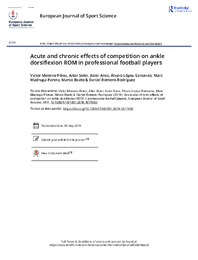Por favor, use este identificador para citar o enlazar este ítem:
https://hdl.handle.net/11000/30758Registro completo de metadatos
| Campo DC | Valor | Lengua/Idioma |
|---|---|---|
| dc.contributor.author | Moreno Pérez, Víctor | - |
| dc.contributor.author | Soler Aguinaga, Aitor | - |
| dc.contributor.author | Ansa, Asier | - |
| dc.contributor.author | López-Samanes, Álvaro | - |
| dc.contributor.author | Madruga-Parera, Marc | - |
| dc.contributor.author | Beato, Marco | - |
| dc.contributor.author | Romero-Rodríguez, Daniel | - |
| dc.contributor.other | Departamentos de la UMH::Patología y Cirugía | es_ES |
| dc.date.accessioned | 2024-01-26T11:31:03Z | - |
| dc.date.available | 2024-01-26T11:31:03Z | - |
| dc.date.created | 2019-05-09 | - |
| dc.identifier.citation | Eur J Sport Sci. 2020 Feb;20(1):51-60 | es_ES |
| dc.identifier.issn | 1536-7290 | - |
| dc.identifier.issn | 1746-1391 | - |
| dc.identifier.uri | https://hdl.handle.net/11000/30758 | - |
| dc.description.abstract | The aim of this study was to investigate the acute (a football match) and chronic (a whole season) effects of competition on ankle dorsiflexion ROM in professional football players. Forty football players participated in this study. Ankle dorsiflexion ROM was recorded to examine acute (pre-match, immediately post-match and 48 h post-match) and chronic (pre-season, mid-season and post-season) effects of competitive football. In addition, it was found that players had restricted mobility measures on ankle dorsiflexion as >2 cm change between baseline measures (pre-match and pre-season). The training load of all played matches was estimated using a global positioning system (GPS) and RPE. Pre-season ankle dorsiflexion ROM was greater compared to mid-season (8.1% in the dominant, and 9.6% in the non-dominant leg) and post-season (13.8% in the dominant, and 12.5% in the non-dominant leg). In addition, around 30% of all players showed restricted ankle dorsiflexion ROM values in post-season compared with pre-season. Related to acute effects, ankle dorsiflexion ROM increased after a match (5.8%) in the dominant ankle, and this value decreased (2.65%) 48 h post-match when post-match measurements in both dominant and non-dominant ankles were compared. The progressive decrease in ankle dorsiflexion ROM throughout a season can be an indicator of increased risk of injury and may be reinforce the need of prevention actions such as stretching exercises and eccentric strength training in professional football players. In addition, these findings suggest to implement specific recovery strategies aiming at minimizing alteration in ankle dorsiflexion ROM 48 h post-match. | es_ES |
| dc.format | application/pdf | es_ES |
| dc.format.extent | 11 | es_ES |
| dc.language.iso | eng | es_ES |
| dc.publisher | Wiley Open Access | es_ES |
| dc.rights | info:eu-repo/semantics/openAccess | es_ES |
| dc.rights.uri | http://creativecommons.org/licenses/by-nc-nd/4.0/ | * |
| dc.subject | Soccer | es_ES |
| dc.subject | Injuries | es_ES |
| dc.subject | Performance | es_ES |
| dc.subject | Fatigue | es_ES |
| dc.subject | Sport | es_ES |
| dc.title | Acute and chronic effects of competition on ankle dorsiflexion ROM in professional football players | es_ES |
| dc.type | info:eu-repo/semantics/article | es_ES |
| dc.relation.publisherversion | https://doi.org/10.1080/17461391.2019.1611930 | es_ES |

Ver/Abrir:
Acute and chronic effects of competition on ankle.pdf
390,72 kB
Adobe PDF
Compartir:
 La licencia se describe como: Atribución-NonComercial-NoDerivada 4.0 Internacional.
La licencia se describe como: Atribución-NonComercial-NoDerivada 4.0 Internacional.
.png)